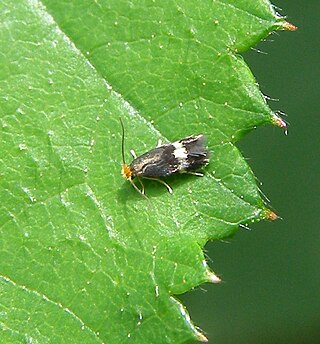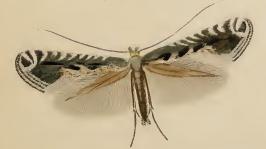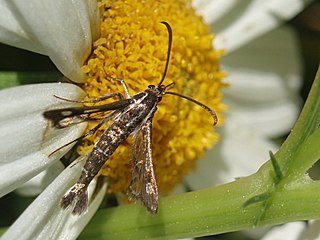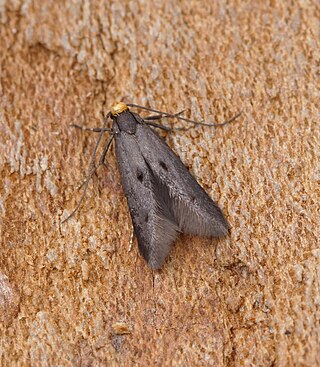
The map-winged swift is a moth belonging to the family Hepialidae and has a patchy distribution throughout Eurasia. The species was first described by Charles De Geer in 1778. It was previously placed in the genus Hepialus and some references still place it there.

Anania hortulata, also known as the small magpie, is a species of moth of the family Crambidae found in Asia, Europe and North America. It was described, in 1758, by the 18th-century Swedish taxonomist, botanist, and zoologist, Carl Linnaeus.

Batrachedra praeangusta is a moth of the family Batrachedridae which is native to Europe. It is also found in North America. It was first described by Adrian Haworth in 1828 from the type specimen found in England. The foodplants of the larvae are poplars and willows.

Eriocrania unimaculella is a moth of the family Eriocraniidae found in Europe. It was first described by the Swedish naturalist Johan Wilhelm Zetterstedt in 1839. The larvae feed inside the leaves of birch, making a mine.

Eriocrania chrysolepidella is a moth of the family Eriocraniidae found in Europe. It was first described by the German entomologist, Philipp Christoph Zeller in 1851. The larvae mine the leaves of hazel and hornbeam.

Parornix anglicella is a moth of the family Gracillariidae found in Asia and Europe. It was described in 1850, by the English entomologist Henry Tibbats Stainton, from a specimen from Lewisham, Kent.

Gillmeria pallidactyla is a moth of the family Pterophoridae first described by the English entomologist, Adrian Hardy Haworth in 1811. It has a Holarctic distribution and is widespread throughout North America and the Palearctic.

Coleophora ibipennella is a moth of the case-bearer family (Coleophoridae). It was first described by Philipp Christoph Zeller in 1849 and is found in Asia, Europe and North Africa. The larva feed within a pistol case on oak leaves and in the past was confused with Coleophora betulella, whose larva feed from a similar looking pistol case on birch leaves.

Stigmella plagicolella is a moth of the family Nepticulidae described by Henry Tibbats Stainton in 1854. It is found in all of Europe and the Near East.

Stigmella aurella is a moth of the family Nepticulidae found in Africa, Asia and Europe. It was first described by the Danish zoologist, Johan Christian Fabricius in 1775. The larvae are leaf miners.
Stigmella sorbi is a moth of the family Nepticulidae, described by Henry Tibbats Stainton in 1861. It is found in most of Europe, east to the eastern part of the Palearctic realm.

Monochroa cytisella is a moth of the family Gelechiidae and found in most of Europe. The larva feed in the stems of bracken causing a slight gall.

Parornix devoniella is a moth of the family Gracillariidae found in Europe. The larvae are leaf miners, feeding on the tissue inside the leaves of hazels Corylus species.

Parornix torquillella is a moth of the family Gracillariidae found in Europe. The larvae mine the leaves of Prunus species, such as blackthorn. It was described by the German entomologist Philipp Christoph Zeller in 1850, from specimens found in Florence, Leghorn and Pisa.

Pyropteron muscaeforme, the thrift clearwing, is a moth of the family Sesiidae that lives in most of Europe.

Coleophora gardesanella is a moth of the family Coleophoridae. It has a disjunct distribution, from Finland to the Pyrenees and Italy, and from Great Britain to the Baltic States and North Macedonia.
Coleophora ptarmicia is a moth of the family Coleophoridae. It is found in Austria, Croatia, Slovakia, the Czech Republic, France, Hungary, Italy, Latvia, Lithuania, southern Russia, and the eastern Palearctic realm. It is also found in China.

Spuleria is a genus of moths of the family Elachistidae. It contains only one species Spuleria flavicaput, which is found in most of Europe and Anatolia. The larvae mine the twigs of hawthorns.

Coptotriche marginea is a moth of the family Tischeriidae, found in most of Europe. It was named by the English botanist, carcinologist and entomologist, Adrian Hardy Haworth in 1828, from a specimen found in England. The larvae mine the leaves of brambles (Rubus) species.

Psychoides verhuella is a moth of the family Tineidae found in Europe. It was first described in 1853, by Charles Théophile Bruand d'Uzelle from a specimen from Besançon, France. It is the type species of the genus Psychoides, also raised by Charles Bruand in 1853. The larvae feed on ferns.




















